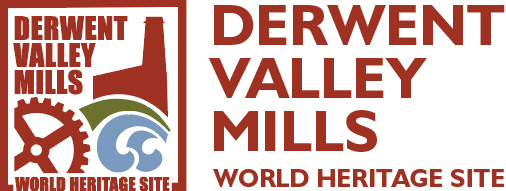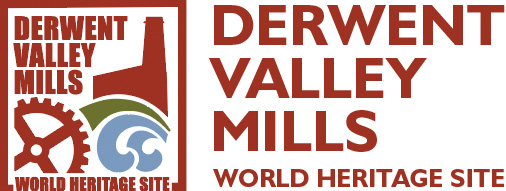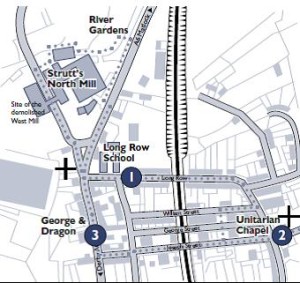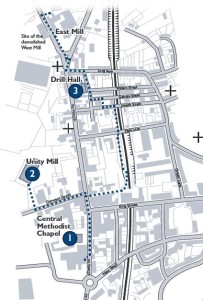Belper Heritage Walks
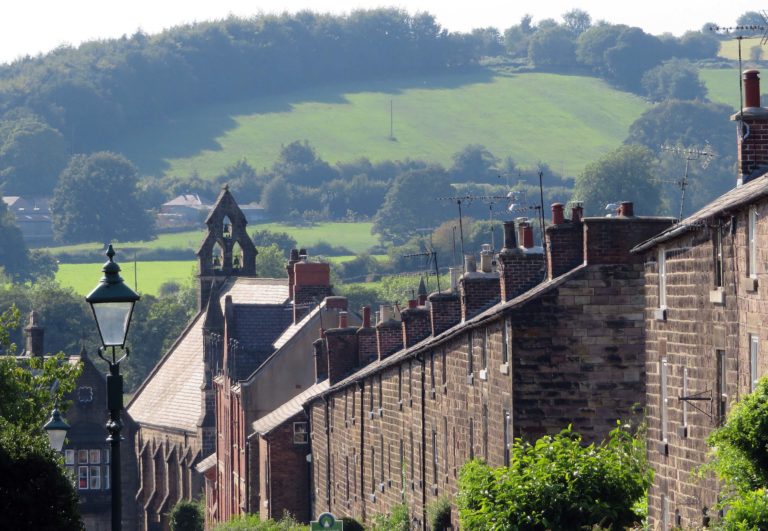
Discover Belper – Belper Heritage Walks
These two Belper heritage walks are set out below, or available as pdfs to download here:
Belper Heritage Walk 1 Leaflet
Belper Heritage Walk 2 Leaflet
Belper is a key community within the Derwent Valley Mills World Heritage Site. It was here that Jedediah Strutt and his sons began their cotton mill business in 1776, and by building and buying homes and facilities for their workers created one of the world’s first industrial communities.
To encourage families to move into Belper and work in their mills, the Strutts built housing for their workers, close to the mills. Nearly all these houses have survived and are still much sought after today. Close by is the mile-long stone-lined railway cutting which has cut through the town since 1838.
The Strutt family were benefactors to Belper and Milford for two centuries, providing for the workers’ needs and there are still many buildings to be seen in the town which were built for the people by the Strutts.
Another great gift to the town was the River Gardens, created and given by George Herbert Strutt in 1906. This water garden by the Derwent still hosts band concerts on alternate Sunday afternoons in the summer.
The importance of the Belper mills and their historic industrial neighbours at Cromford, Darley Abbey and Derby was reflected by the World Heritage Site status given to the Derwent Valley Mills in December 2001. Belper is also within the National Heritage CorridorTM.
Heritage Walk 1
This short walk looks at some of the most significant buildings near to the Strutt mills. The starting point is the Derwent Valley Visitor Centre reception, inside Strutt’s North Mill. During your walk you will see the interpretation board on the railway bridge in Long Row, which will tell you more about this industrial community, and show you how it has changed in the past two centuries.
Jedediah Strutt built water-powered cotton spinning mills in Belper from 1776. The North Mill of 1781 was re-built in 1804 after fire destroyed the original mill. William Strutt designed this, using innovatory construction methods, as a fireproof building; it was an important development in the building of multi-storey structures. This mill is one of the most significant elements of the Derwent Valley Mills World Heritage Site.
The Horseshoe Weir and sluice gates were built in 1797 to replace an earlier weir and gain better control of the River Derwent to power the mills. It is one of the finest in the UK. Take the path by the weir, which runs alongside the river to The River Gardens. This is where willow was grown to make baskets for transportation of goods at the mills. George Herbert Strutt agreed to a landing stage being built here. This idea developed into the River Gardens. Band concerts are held here and boats may be taken out on the river.
Across from the Matlock Road entrance to the River Gardens is “The Old Nick”, Belper’s former police station, built in 1847. For two years it served as the headquarters of the Derbyshire Constabulary when it was first formed in 1857. Three police houses were built alongside in 1877. Cross at the lights towards these houses and turn right.
On the right, across the road from Long Row is Christ Church and vicarage, built in 1850. Turn left up Long Row. The first Long Row schoolroom was built about 1818; it was later rebuilt and enlarged. Some houses were demolished to accommodate the larger school building.
Long Row is a second phase of millworkers’ housing built about 1790 by the Strutt family. The rows of houses on the left and at the bottom right have a continuous roofline with an extra storey; built of gritstone and interlock around the staircase. The brick houses on the right ascend in steep pairs. All these houses have ample gardens.
On the right by the railway bridge is a walled area, known as the dirt hole. Here people emptied their ashes to be collected by the ash cart. The North Midland Railway came through Belper between 1838 and 1840 as part of the Derby to Leeds line. There are 11 bridges in the one-mile that it runs through Belper. Four or five houses in each row had to be demolished for the cutting to go through.
Turn right into Green Lane. On your left there are four short rows of cottages, these were the first phase of Strutt housing, about 1780. Mill Street has since been extended and the houses on the right lost their gardens.
You are now entering The Clusters. Cluster buildings are blocks of four houses, semi-detached and back-to-back, each with a pigsty. The cluster rows were the third phase of workers’ housing, built about 1818-1820 and named in 1896 after Jedediah’s three sons. Turn right into William Street, then at the first lamp post on the left, turn left and pass through the channel (or alley) into George Street. The more modern George Street houses were built from 1840 onwards and there has been some infilling since then. Cross the road and go through another channel into Joseph Street. The house on the right is a fine example of a cluster house.
Turn up Joseph Street and on the left is a Nail Shop built in the early 19th century. Most of the millworkers were women and children. Various workshops were built within the housing complex to provide employment for men.
At the top of Joseph Street, cross the road into Field Row. On the left is the Unitarian Chapel, built in 1788 and extended on both sides early in the 19th century. The chapel is three times its original size. It is a good example of nonconformist architecture. There is a fine external, cantilevered staircase, which gives the only access to the upper gallery. Several members of the Strutt family remains are contained in a catacomb below the Chapel.
Back to Green Lane, walk back down Joseph Street. At the bottom, walk through the small entry in front of you, and continue down Crown Terrace until you are on Bridge Street. Turn right, towards the mills. The George and Dragon on the opposite side of the road was a coaching inn and served as an early post office. The old Savings Bank is opposite the George and Dragon. William Strutt was a founder of the Savings Bank, in 1818. It moved to these premises in 1851, later becoming a branch of the TSB. The ornate stonework front was added in 1910.
Cross at the lights and follow the signs for the Derwent Valley Visitor Centre. Strutt mills became part of the English Sewing Cotton Co. in 1897. The big East Mill was built in 1912. In the mill yard the engine house and the remaining stump of the mill chimney can be seen, built in 1854 when the mills began using steam power. The stone arch over the road is the Gangway, built in 1795 to connect the now-demolished West Mill to the North Mill. In 1810 holes were made where muskets could be fired at any troublemakers. Return to the Derwent Valley visitor Centre in Strutts’ North Mill.
Heritage Walk 2
Past Industries and Places to See
Belper has a strong industrial past, with cotton spinning, hosiery production, nail-making and the iron foundries providing thousands of jobs for many years. This walk begins at De Bradelei Mill, once the HQ of George Brettle and Co, one of the most renowned manufacturers of hosiery and other cotton goods. On this site, stockings were produced for George III and his grand-daughter Queen Victoria, and the cotton vest worn by Admiral Horatio Nelson at the Battle of Trafalgar in 1805. The interpretation board under the arches leading to the car park will tell you more about the company.
Walk through the large arch on to the main road – this is the A6, which follows the line of the turnpike road provided between Derby and Manchester in 1816-18. From the archway, look right and you will see the large gritstone warehouse of 1850 on the far side of the roundabout. This belonged to Wards, another major hosiery company.
Turn left, walking along the A6 towards the town centre. Next to De Bradelei Mill is the Central Methodist Chapel of 1807.
Continue along the road, then turn left down a channel just before the crossing. The large building in front of you is now the library but was part of a Thorntons factory. The toffee manufacturer came to Belper in 1947. Before then it was a hosiery factory. The library was once a music hall, where Gracie Fields performed. Turn left at the far end of the library and you’ll see more of the old factory frontage. Opposite it is the entrance to Unity Mill. Walk through to see the 1839 corn mill built by James Webster and enlarged by John Strutt from 1853. It was later converted to cotton spinning, then furniture production but is now an antiques centre.
Return up Derwent Street to Bridge Street (the A6), cross the road and walk under the arch by the Frearson’s shop into Wellington Court. On the left is Wellington House where Will Hay, star of Ealing film comedies, stayed as he began his career in Belper. At the end of the stone terrace follow the road ahead past the supermarket to the railway station of 1878. From the first platform you can see the recesses which once held the station buildings, and beyond these, looking north, the five road bridges which cross the stone-lined cutting designed by George Stephenson.
Walk up the steps from the platform and follow the footpath which runs parallel to the platform, until you come out on Field Lane. Cross the road onto another path running parallel to the railway cutting. This is The Ropewalk, so called because it runs at right-angles to a former ropewalk used for rope-plaiting.
At the end of the ropewalk we are in Joseph Street – part of the industrial housing built by the Strutts. Note the Telford/Macadam type road surfacing to the right of you.
Turn left and walk down the road until you reach No 3 Clusters Court – opposite is a channel to George Street. Walk along it. As you pass through the channel note the old workshop on your left, now converted into a house. Although the Strutts primarily only wanted women and children in the mills, they provided workplaces like these for men so whole families would settle in the town.
At end of the channel turn left, past some of the Strutts’ cluster houses (semi-detached and back-to-back), then at the bottom of the road turn right. You are now in Cluster Road. On the Drill Hall of 1902 on the left is a painted bell and arrow – to help people find and ring the church bells in case of a wartime invasion. Piggy Hill, the channel just past the drill hall, running down to the main road, was used from 1896 by butcher Edward Ryde to her in his fresh stocks of pigs.
At the end of Cluster Road turn left onto Long Row. On the right as you walk down to the A6 is Long Row School, provided by the Strutts for the community in 1818. In front of you, across the road is Christ Church of 1850. Bear right and cross the road at the crossing. You are now in The Triangle, where there is an interpretation panel on the mills. On the left is Pyms, a solicitor’s office once used for the mill armoury. Cross the road again, this time towards the big red mill, the East Mill of 1912. Turn left and under the bridge linking the buildings on opposite sides of the road. This is the Gangway of 1795. Turn right into the next car park. Here you will find more information at the Strutt’s North Mill museum.
To return to De Bradelei Mill simply return to The Triangle, turn right and follow the A6 road.
